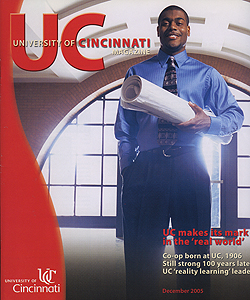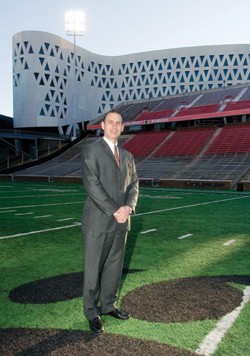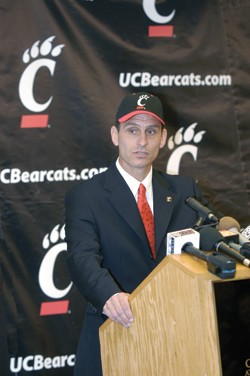New University of Cincinnati athletic director Mike Thomas took over for the retiring Bob Goin Dec. 1, 2005. The former AD at Akron and assistant AD at Virginia discusses his philosophy for recruiting better student athletes, improving football attendance and moving on after basketball coach Bob Huggins' departure in August.
Interview conducted Oct. 31, 2005.
Q: What is your management style?
A: I very much have an open-door policy. I want to be very approachable, even with our student athletes. I want them to know they are always welcome.
I don't want people who are 'yes' people. I want people who can actually challenge me. I'm a very strong motivator. I don't call it TLC, I call it TRC, "Trust, Respect and Care." And I think if you do those things with your staff, you are going to have motivated people around you.
Q: What is most rewarding about college athletics?
A: The most rewarding thing to me is being a part of the lives of the student athletes. Because when I'm up on the stage on graduation day, and I see them walk across that stage and receive their diploma, that is a big deal. To see them achieve at the highest level is exciting. It is almost like watching a plant in bloom. Watching someone come in as a freshman and leave four or five years later and see how much they have grown -- athletically, academically and socially -- that's really a big deal.
Q: What's most challenging in this business?
A: No matter where I've been, you never feel like you have enough resources. People always want a bigger slice of the pie. That's all well and good, but somebody's got to go out and start baking their own pies. So it is my job to make sure we are doing those things to bring in additional revenue so we can enhance the opportunities for our student athletes.
Q: You have said that academic success and athletic success are not mutually exclusive. Why?
A: Because I've experienced it. When you have lived it, it is easy to say. I've been a part of programs that have had a high degree of success competitively, but they have also graduated their student athletes.
That starts in the recruiting process, and it is a culture that is important for your staff and coaches to buy into. Once you get those kids on your campus, you need to make sure you are doing everything you can to support them so you are seeing increased GPAs and increased graduation rates.
Q: How do you change the perception that programs can't win championships and also graduate players who are good citizens?
A: How you change that is by bringing in kids who can succeed at both athletics and academics, who are great citizens in the community. And once you've done that, then people will start to believe.
Let's face it. It is very competitive. We are all trying to recruit the best athletes, the person who is going to give us the best chance to win on the field of competition. It shouldn't be any different when we try to recruit the best students who also are the best athletes.
Maybe we are recruiting against a different type of school now. We very well may be. But I don't think it is an impossible task by any means. It is a mindset.
And I'm not sitting here saying the coaches on the current UC staff feel different from that. I haven't had these kinds of conversations with any of the coaches yet. But my sense is that most of them would welcome that opportunity, and many are probably looking in that direction already and have been for a number of years.
Q: Is there a program that you could use as a model for UC?
A: I was at UVA for seven years. That is probably one of the top two public institutions in the country. And that was a situation where we were graduating 80 to 90 percent of our student athletes every year. They won a number of national championships when I was there. Now they were mainly in Olympic sports, but we went to a bowl game every year I was there, and basketball was fairly successful, in what, for the time, was probably the toughest basketball conference in the country.
That may not be the perfect model for Cincinnati, because we are in an urban setting. I'm not sure if there is one particular model, but it might be a combination of models that make the most sense for us.
Q: The academic success of Akron's student athletes has been well documented. What made the difference in moving the needle there?
A: I restructured the whole academic services area, and I added staff. Then I did a lot of things with our physical space, including a new computer center. The final thing was putting more money into summer school and fifth-year aid, which kept kids on track to graduate.



